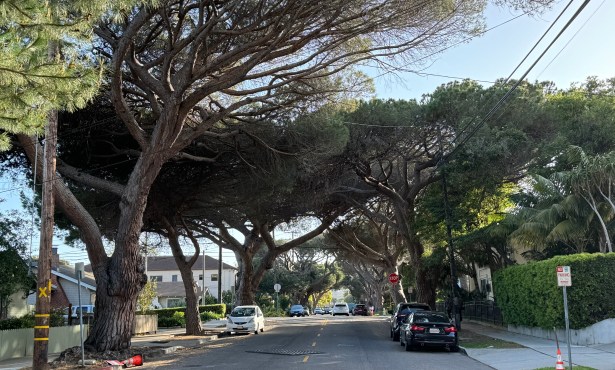Holes in the Safety Net
Low-Income Program Has No Emergency Housing

On the Thursday before the Summer Solstice parade, June 20, I woke from a nap and saw to my horror that the entire next-door apartment building was completely engulfed in flames. I scrambled to get my mother and my brother out of the house. While the firefighters of Santa Barbara put out the fire, spectators who lived nearby watched our apartment burn as if it were live entertainment.
As our belongings, security, and lives went up in fire and smoke, a fireman asked if we were in need of emergency services. In shock, we told him yes, and so began my Alice in Wonderland experience with “emergency housing services.” The Red Cross arrived at 3:30 a.m. to secure emergency housing for the weekend and gave us a $95 debit card for food. Still in shock, I wondered, What happens Monday?
My apartment building is owned by the Santa Barbara Community Housing Corporation, a private low-income housing organization that owns different properties in the area and works with the city Housing Authority (HACSB) accepting Section 8 vouchers for federal, city, and county grants. My landlord advised me that he had no vacancies. We had no choice but to go back to our Section 8 apartment.
My mother’s bedroom, the kitchen, and the living room were less damaged than my room from the fire. As cleaned up the mess, I contacted my case manager at the HACSB, who said the agency would try to find housing but that my landlord had to help me find a place since the fire was not our fault. Since my landlord had no vacancies, I asked HACSB about its emergency housing services. When I received Section 8 three years ago, I was told that the disabled, senior citizens, and those in need of emergency housing were given the highest priority. I am my mother’s caregiver; she is 68 years old and seriously disabled with health issues such as osteochondral lesions in both knees (no cartilage) — a painful, crippling problem — herniated discs in her upper and lower back, diabetes, a heart condition, and a colostomy bag that I change every other week. We are both low income since her income consists of SSI and mine unemployment since I was laid off by the very company I rented from and work part-time as my mother’s in-home supportive services caregiver. I believed we more than met the criteria of “emergency housing.” I was wrong.
HACSB did not place us in one of its many available apartment units. The Housing Authority had a partner nonprofit counseling agency meet with us to assist in locating a place, but the counselor revealed that this could take anywhere from a couple of months to a couple of years. The counselor referred us to www.gosection8.com to look for Section 8 apartments or homes. This sounds like a win right? We can take our Section 8 to any place that accepts Section 8. Well, the catch is, the agency does not locate the landlords for you. You have to locate the landlords on your own. And no landlord accepts section 8 in Santa Barbara. Those very few who do are full.
In my search for a new home I found that landlords view Section 8 holders as poverty-stricken, almost homeless, troublesome rabble and squalid property risks. The 10-year outdated list of property management companies given to me by HACSB had no vacancies whatsoever for Section 8. Other private nonprofit low-income housing organizations all have waiting lists. People’s Self-Help Housing, which has a contractual partnership with HACSB, advised me that it has a one- to three-year waiting list and performs credit checks on all applicants, who must pay a $20 fee per application. This nonprofit agency like a lot of other nonprofit agencies receives grant monies just for being a nonprofit housing agency, yet it charges $20 per application and runs credit checks on low income people, which is the target population that it is supposed be assisting. It had no emergency housing assistance services for my mother and me, even though Self-Help Housing and HACSB have a joint low-income property in which they could’ve housed us.
When I called the Red Cross and explained the issues we were experiencing, the Red Cross told us that we should go to the homeless shelter Casa Esperanza for housing services. Little did they know that Casa Esperanza also has a waiting list. So does Salvation Army’s Hospitality House, and usually these services are for single adults and not for an adult male who is the caregiver for his disabled and senior citizen mother.
My landlord was now telling me that my mother and I had to vacate the premises. I had to consult with an attorney to understand my legal rights, and I learned that a landlord is not responsible for the loss of a tenant’s personal items. Tenants are responsible for obtaining renter’s insurance to safeguard against tragedies such as mine. Nor is the landlord responsible for the temporary housing of the tenant. However, the law does state that one the propery is repaired, a landlord must offer the premises back to the renter. Once my landlord heard that I had consulted an attorney, he cut a $1,000 check for assistance, returned our $1,118 deposit, and returned our $62 prorated rent. That was all we had to cover what we had lost in the fire, to help us move, to help us start over. It went to food, an ice chest, and application fees and credit checks for apartments in Ventura and Santa Barbara and Lompoc. Luckily, with the help of my brother and friends, we found a place in Lompoc. Non-Section 8, of course. My brother had to move in with us to help us financially.
During my ordeal, I learned that all the housing services in Santa Barbara did not, in fact, have emergency housing programs at all. All they had were outdated lists, waiting lists, and time-consuming procedures and protocols. As The Santa Barbara Independent wrote on July 17, 2013, the county’s Lompoc Housing and Community Development was investigated by the federal government for misspending or failing to report expenditures of grant monies totaling, since 2005 to present, $10.8 million, which was given for subsidized housing for the low- and very low-income communities. The feds would do well to audit all nonprofit agencies that also work with the County of Santa Barbara and other interlocking agencies that are funded by these very grants. The services these grant monies are supposed to be funding aren’t being given to the communities that need them. Where is this money going?
While this impropriety is ongoing, people remain homeless and destitute, and the social services arena continues to be infested with corruption. This is why the homeless, low-income, and poverty-stricken communities of Santa Barbara never seem to get better. We’re not allowed to. We are being victimized by the very agencies receiving federal grants to help us.



